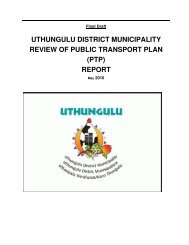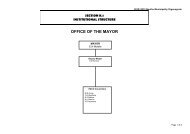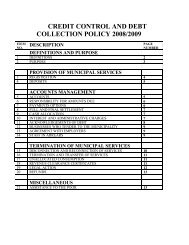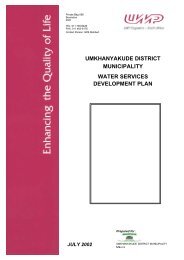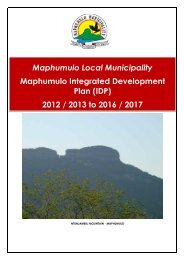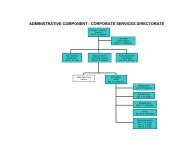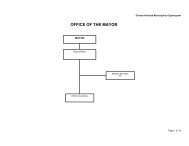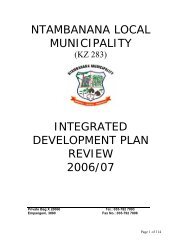2013_14 IDP Review.pdf - KZN Development Planning
2013_14 IDP Review.pdf - KZN Development Planning
2013_14 IDP Review.pdf - KZN Development Planning
- No tags were found...
Create successful ePaper yourself
Turn your PDF publications into a flip-book with our unique Google optimized e-Paper software.
extension within the municipal area could be identified although greateremphasis can be put on secondary and tertiary roads feeding into andlinking with the R33. The R33 is the backbone of the movement systembut it needs urgent maintenance and upgrading in some areas. The singlelane bridges over the Tugela and Mooi Rivers do not seem to be a seriousconstraint of movement at this stage. However, both bridges require urgentmaintenance.Service networksThe nodal areas do have access to all major services. There is very littlegrowth pressure in the nodal areas and the focus should rather be onsustaining systems through maintenance. The rural and commercial areasare covered by bulk infrastructure where necessary. The electricitynetwork is well developed and water service in the extensive low-densitysettlement areas might be hampered by borehole equipment not working.In essence, the emphasis should again priorities rehabilitation andmaintenance of existing water infrastructure. Given the low-density natureof the rural areas and the inability to recover, any service costs in theseareas a service delivery strategy should aim at providing only the verybasic services and then where it is absolutely necessary.There seems to be a tendency to develop large-scale water networks. Ifthis is the case then one should assume that the current settlement profileis accepted and that it is entrenched and restructuring and optimising ruralsettlement over the long-term does not form part of any strategy of theDistrict or any of local municipalities involve. The net effect might be a defacto acceptance of the current development scenario. This is underscoredby an approach of taking facilities to people rather than bringing people tothe required facilities as contemplated, for example, in the Nqutu SDF andthe service delivery strategies put forward by provincial and national sectordepartments as part of Umzinyathi’s LED programme.SurfacesThe areas filling the gaps between the nodes and networks are utilised forfive main groups of activities. These activities have been assessed indetail but it is worth highlighting some key aspects.11.5.3 Conservation CorridorsThe Umzinyathi SDF identified and recognised two main ConservationCorridors or areas in the municipality. The first is the Biggarsberg runningfrom west to east through the northern part of the municipal area. It startsbetween Glencoe and Wasbank and runs past Helpmekaar eastwardstowards the Nqutu boundary south of Mangeni. From Helpmekaar to theNqutu boundary it delineated by the northern boundary of the greaterTugela valley and then in the east by the Buffalo River valley cutting intothe Tugela River Valley from the north. There are currently no formalprotected areas in this corridor or any indication that conservation isactively promoted. On the contrary, large parts of this area is severelydegraded and scarred by agricultural and low-density settlement practices.The second area is described by the southern boundary of the Tugelavalley where the elevation is more than 100m above sea level. The areasstretches from Muden to Kranskop Again there are no formal conservationactivities or protected areas in this zone. Conservation is a matter thatshould achieve attention.Biodiversity Priority AreasThe SDF recognises the <strong>KZN</strong> Wildlife conservation priority areas. Itincludes Biodiversity Priority 1 and 3 areas. The SDF also shows theProtected Area Expansion areas, the provincial Environmental Corridors,existing Protected Areas, Natural Heritage Sites and Conservancies.High potential development areaThe areas around Dundee and Glencoe (First order node) was identifiedas an area vir a diverse potential. It in not only includes a substantialpopulation concentration and business and community facilities, it is alsoan area with relatively high agricultural potential on an proven but latentpotential for coal mining. It is the heart of the battlefield tourism initiativesand the area had highly accessible through inter regional road and railwaylinks.High potential agricultural landThe PGDS identifies only the area around Greytown as an “agriculturalinvestment area”. However, this area already taken up forestry activities.However, the ARC indicates significantly more areas as category 2 and 3Draft <strong>2013</strong>/<strong>14</strong> <strong>IDP</strong> <strong>Review</strong> Page 208Prepared by Umzinyathi District Municipality22 March <strong>2013</strong>



